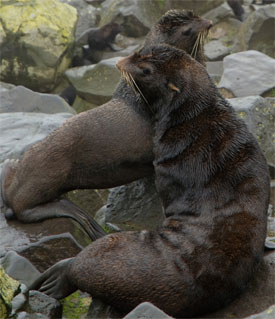Esperanza Heads South to Dutch Harbor with New Insights
Location of Pinnacles Remains a Mystery

A Dall’s porpoise (top) gives Michelle Ridgway in DeepWorker a sendoff before her dive to 1,700 feet at Zhemchug Canyon in this surreal looking image. Hundreds of Dall’s porpoises were present around the ship during the expedition. (Video still by David E. Guggenheim)
The Esperanza began its 2-day steam south and endured gale-force winds and 15-foot seas along the way, but all are well and grateful for the successes along the way. The team achieved a total of 25 sub dives during the expedition, well-exceeding expectations for this part of the world where weather is typically unforgiving.
The team collected nearly a Terabyte (1,000 Gigabytes) of high-definition video, photographs and other data, now being archived, cataloged and distributed. Also collected were numerous coral, sponge, and other invertebrate samples which are being prepared for distribution to scientists around the world for further analysis. Read more




